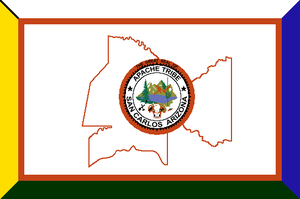San Carlos Apache Indian Reservation
|
Flag of the San Carlos Apache Nation
|
|
| Total population | |
|---|---|
| (15,393) | |
| Regions with significant populations | |
| United States (Arizona) | |
| Languages | |
| Southern Athabaskan, English, Apache | |
| Religion | |
| Traditional Tribal Religions, Christianity | |
| Related ethnic groups | |
| Apache, Navajo, Dene |
The San Carlos Apache Indian Reservation, in southeastern Arizona, United States, was established in 1872 as a reservation for the Chiricahua Apache tribe as well as surrounding Yavapai and Apache bands forcibly removed from their original homelands under a strategy devised by Gen. Crook of using an Apache to catch an Apache. Also known as "Hell's Forty Acres" under United States occupation because of deplorable health and environmental conditions, today's San Carlos Apaches successfully operate a Chamber of Commerce, the Apache Gold Casino, a Language Preservation program, a Culture Center, and a Tribal College.
On December 14, 1872, President U.S. Grant established the San Carlos Apache Reservation. The government gave various religious groups responsibility for managing the new reservations, and the Dutch Reformed Church was in charge of the San Carlos Apache Indian Reservation. The church chose John Clum, who turned down the position twice before accepting the commission as Indian Agent for the San Carlos Apache Indian Reservation in the Arizona Territory on February 16, 1874.
The U.S. Army showed both animosity toward the Indians and disdain for the civilian Indian Agents. Soldiers and their commanding officers sometimes brutally tortured or killed the Indians for sport while politicians in Washington, D.C., knew little about differences in tribal cultures, customs, and language. Politicians also ignored political differences and military alliances and tried to apply a “one-size-fits-all" strategy to deal with the “Indian problem”. As a result, tribal friends and foes were forced to live in close proximity to one another. Meanwhile, the Apaches were supposed to be fed and housed by their caretakers, but they rarely saw the federal money and suffered as a result.
Clum arrived at the reservation on August 4, 1874. During his tenure at San Carlos, he struck a lifelong friendship with Eskiminzin, an Aravaipa Apache chief, and persuaded many of the White Mountain people to move south to San Carlos. Clum won the Indians' confidence and the Apaches responded by turning in their weapons. The Apaches formed a tribal court to try minor infractions and joined the Tribal Police organized under Clum's command, which helped to form a system of limited Indian self-rule. The agent soon attracted 4,200 Apache and Yavapai Indians to the semi-arid reservation. The Army bristled at Clum's actions because they prevented them from taking part of the funds that passed through the reservation.
...
Wikipedia

